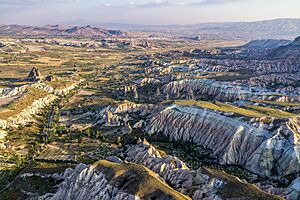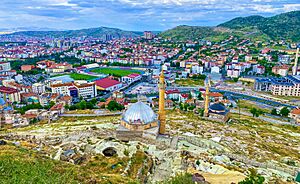Nevşehir facts for kids
Quick facts for kids
Nevşehir
|
|
|---|---|

Panoramic view from Nevşehir Castle
|
|
| Country | Turkey |
| Province | Nevşehir |
| District | Nevşehir |
| Elevation | 1,224 m (4,016 ft) |
| Population
(2022)
|
123,882 |
| Time zone | TRT (UTC+3) |
| Postal code |
50300
|
| Area code | 0384 |
Nevşehir (pronounced 'nev-sheh-heer') is a city in the middle part of Turkey. Its name means "new city" in Turkish. It's the main city of the Nevşehir Province and has about 123,882 people living there (as of 2022).
Nevşehir is about 290 kilometers (180 miles) from Ankara, which is the capital city of Turkey. It's also located in the famous historical region called Cappadocia. The city sits high up, about 1,224 meters (4,016 feet) above sea level.
The weather in Nevşehir is quite varied. Winters are cold with lots of snow, while summers are hot and dry. Even though Nevşehir is close to amazing places like underground cities, fairy chimneys, old monasteries, and rock-cut churches, the modern city itself isn't a huge tourist spot. However, in 2015, a giant underground city was found right beneath the city center!
Nevşehir also has its own university, which was started in 2007 and is now called Nevşehir Hacı Bektaş Veli University. If you want to fly there, Nevşehir Kapadokya Airport is about 30 kilometers (19 miles) away. There are also plans for fast train services to connect Nevşehir to other big cities like Antalya and Ankara.
Contents
History of Nevşehir

Early Times and Ancient History
The very first settlement in this area was called Nissa. It was founded by the Hittites on the slopes of Mount Kahveci. Later, it was known as Soanda and Seandos. Over time, different powerful groups ruled this land. The Assyrian Empire took over around 800 BC, then came the Medes, and after that, the Persians in 546 BC.
In 333 BC, Alexander the Great defeated the Persians. After he died, the area became part of a kingdom ruled by the Ariarathes family. Their capital city was Mazaka, which is now Kayseri. Eventually, this kingdom became a part of the mighty Roman Empire when Emperor Tiberius was in charge.
Medieval History and Underground Cities
The amazing underground cities you can find around Nevşehir might have been built a long, long time ago. Some people think they were made by the Hittites. Others believe they were built by early Christians to hide from the Roman authorities who didn't like their religion. Many churches carved into the rocks also come from these early Christian times.
Even after Christianity became the official religion of the Roman Empire, these caves were still useful. They protected local people from attacks by the Sassanid Persians around AD 604 and later from the Islamic Caliphate starting in AD 647. During a time in the Byzantine Empire when certain religious images were destroyed (called Iconoclasm), the caves around Nevşehir again became safe places for those who were being persecuted. For a long time, Nevşehir was known as Neapolis, which means "New City" in Greek.
The castle on the hill in the middle of Nevşehir was built during the Byzantine period. This was a time when the region was often on the front lines of wars against the Islamic Caliphate.
In AD 1071, a big battle happened at Malazgirt. The Byzantine emperor was defeated by the Seljuk Sultan Alp Arslan. This led to the Seljuks taking over much of Anatolia by 1074. Nevşehir became part of the Seljuk Sultanate of Rum. Later, it was ruled by the Karamanid family in 1328. Finally, it became part of the Ottoman Empire around 1487 AD. At this time, its name was changed to Muşkara. It stayed a small, quiet village until the early 1700s.
Modern History and a New Name
The city we see today really grew thanks to a very important person named Nevşehirli Damat İbrahim Pasha. He was a grand vizier (like a prime minister) and the son-in-law of Sultan Ahmed III. He was born in Muşkara and cared a lot about making it bigger and better.
This small village, which only had 18 houses, quickly changed. New mosques were built, like the Kurṣunlu Mosque. There were also new fountains, schools, soup kitchens, inns, and bathhouses. The name of the village was changed from Muşkara to "Nevşehir," which means "New City" in Persian and Ottoman Turkish. In 1730, the grand vizier was sadly killed by rebels. But by then, Nevşehir was already a well-established town.
In the late 1800s, a census showed that Nevşehir had about 39,822 people. Most were Muslims, but there were also many Greeks and some Armenians. After a population exchange between Greece and Turkey in 1923, the Turkish-speaking Greek Orthodox community from Nevşehir moved to Greece, and Muslims from Greece moved to Nevşehir.
Economy
The economy of Nevşehir mainly relies on two things: farming and tourism. The beautiful landscapes and historical sites of Cappadocia bring many visitors to the region.
Sightseeing
In Town
- Kurşunlu Mosque: This is a special mosque from the early 1600s in the city center. It shows off the unique style of Ottoman architecture.
- Nevşehir Castle and Kayaşehir: Explore the old castle and the nearby Kayaşehir, which is a fascinating rock-cut settlement.
- Meryem Ana Kilisesi: Also known as the Mother Mary Church, it's located close to Nevşehir Castle.
- Hagios Georgios Church: This church is also called the 'Çanlı Church' and is near Nevşehir Castle.
- Green Valley: A lovely area with restaurants and gardens near the town of Nar.
- Nevşehir Veterans Stadium and Nevşehir Football Stadium: Places for sports events in the city.
Around Town
- Uçhisar: A famous rock-cut castle in the Cappadocia region, offering amazing views.
- Churches of Göreme: Many ancient churches carved into the rocks in the Göreme Open-Air Museum, a UNESCO World Heritage site.
Climate
Nevşehir has a continental climate. This means it has cold, snowy winters and warm, dry summers. Rain falls throughout the year, but there's a bit more in the spring.
The highest temperature ever recorded in Nevşehir was 39.5°C (103.1°F) on July 30, 2000. The lowest temperature ever recorded was -23.6°C (-10.5°F) on February 4, 1960.
| Climate data for Nevşehir (1991–2020, extremes 1959–2023) | |||||||||||||
|---|---|---|---|---|---|---|---|---|---|---|---|---|---|
| Month | Jan | Feb | Mar | Apr | May | Jun | Jul | Aug | Sep | Oct | Nov | Dec | Year |
| Record high °C (°F) | 19.8 (67.6) |
19.6 (67.3) |
28.0 (82.4) |
31.6 (88.9) |
32.6 (90.7) |
35.0 (95.0) |
39.5 (103.1) |
38.2 (100.8) |
37.4 (99.3) |
32.0 (89.6) |
27.6 (81.7) |
23.0 (73.4) |
39.5 (103.1) |
| Mean daily maximum °C (°F) | 4.1 (39.4) |
6.0 (42.8) |
10.9 (51.6) |
16.3 (61.3) |
21.2 (70.2) |
25.6 (78.1) |
29.3 (84.7) |
29.4 (84.9) |
25.3 (77.5) |
19.1 (66.4) |
11.6 (52.9) |
6.2 (43.2) |
17.1 (62.8) |
| Daily mean °C (°F) | 0.0 (32.0) |
1.3 (34.3) |
5.5 (41.9) |
10.4 (50.7) |
15.0 (59.0) |
18.9 (66.0) |
22.2 (72.0) |
22.1 (71.8) |
18.1 (64.6) |
12.8 (55.0) |
6.3 (43.3) |
2.0 (35.6) |
11.2 (52.2) |
| Mean daily minimum °C (°F) | −3.5 (25.7) |
−2.6 (27.3) |
1.0 (33.8) |
5.2 (41.4) |
9.3 (48.7) |
12.3 (54.1) |
14.6 (58.3) |
14.5 (58.1) |
11.3 (52.3) |
7.4 (45.3) |
2.1 (35.8) |
−1.4 (29.5) |
5.9 (42.6) |
| Record low °C (°F) | −21.2 (−6.2) |
−23.6 (−10.5) |
−18.0 (−0.4) |
−12.5 (9.5) |
−2.3 (27.9) |
1.3 (34.3) |
3.8 (38.8) |
3.1 (37.6) |
−1.2 (29.8) |
−7.6 (18.3) |
−14.0 (6.8) |
−19.5 (−3.1) |
−23.6 (−10.5) |
| Average precipitation mm (inches) | 43.7 (1.72) |
41.8 (1.65) |
47.5 (1.87) |
45.7 (1.80) |
57.4 (2.26) |
37.5 (1.48) |
9.9 (0.39) |
9.6 (0.38) |
13.7 (0.54) |
29.4 (1.16) |
33.4 (1.31) |
48.4 (1.91) |
418.0 (16.46) |
| Average precipitation days | 12.13 | 11.7 | 13.03 | 11.97 | 13.37 | 8.27 | 2.27 | 2.17 | 3.5 | 7.2 | 8.27 | 11.77 | 105.65 |
| Average snowy days | 8.9 | 5.7 | 6.8 | 1.5 | 0 | 0 | 0 | 0 | 0 | 0.2 | 1.8 | 5.3 | 30.2 |
| Mean monthly sunshine hours | 96.1 | 118.7 | 164.3 | 204.0 | 257.3 | 309.0 | 365.8 | 347.2 | 276.0 | 195.3 | 138.0 | 86.8 | 2,558.5 |
| Mean daily sunshine hours | 3.1 | 4.2 | 5.3 | 6.8 | 8.3 | 10.3 | 11.8 | 11.2 | 9.2 | 6.3 | 4.6 | 2.8 | 7.0 |
| Source: Turkish State Meteorological Service, Meteomanz(snow days 2013-2023) | |||||||||||||
Images for kids
-
Nevşehir municipality offices and statue of Atatürk
See also
 In Spanish: Nevşehir para niños
In Spanish: Nevşehir para niños





















